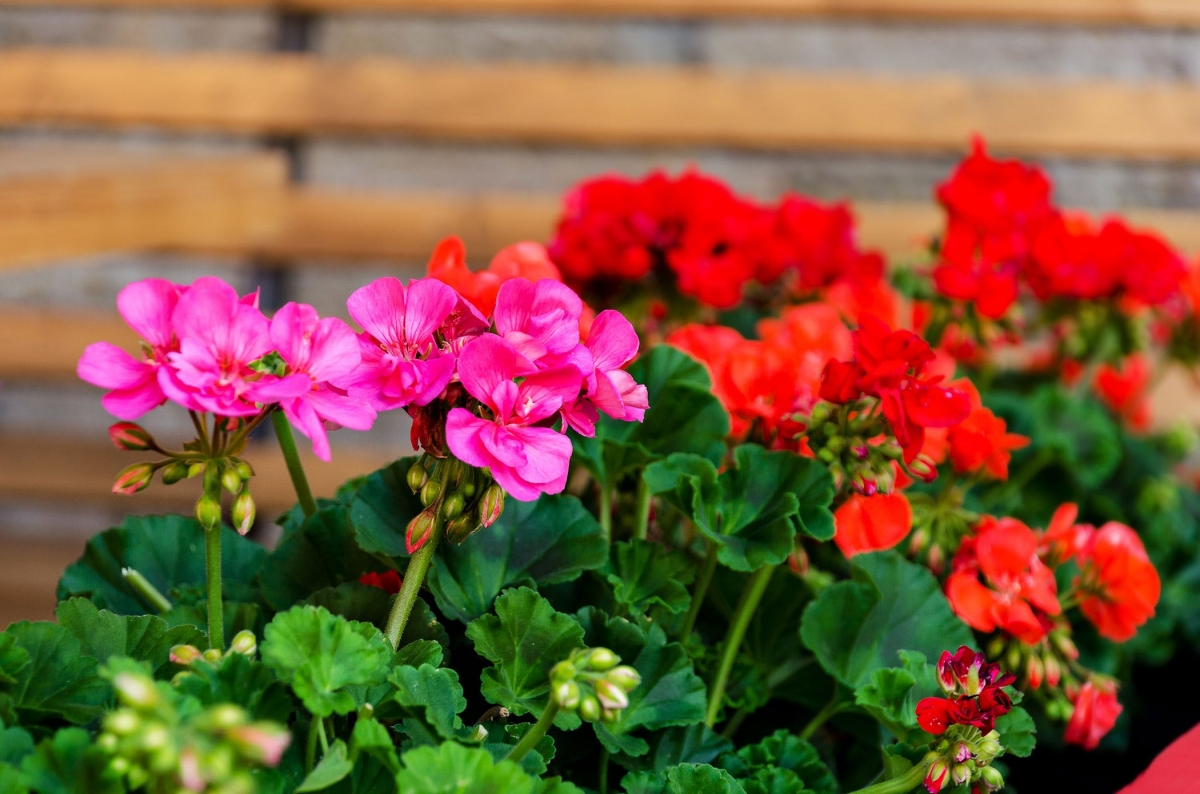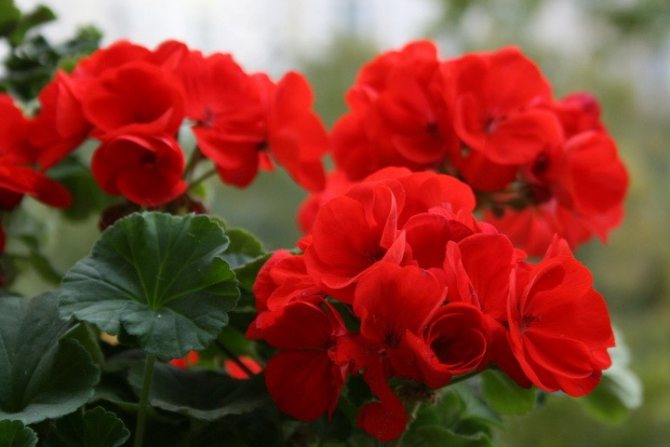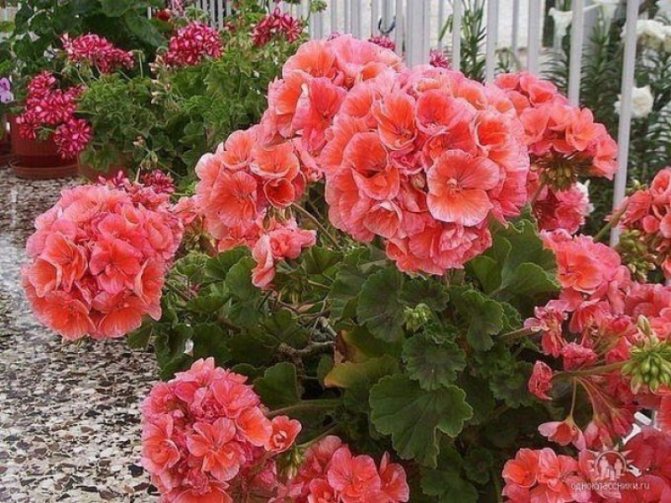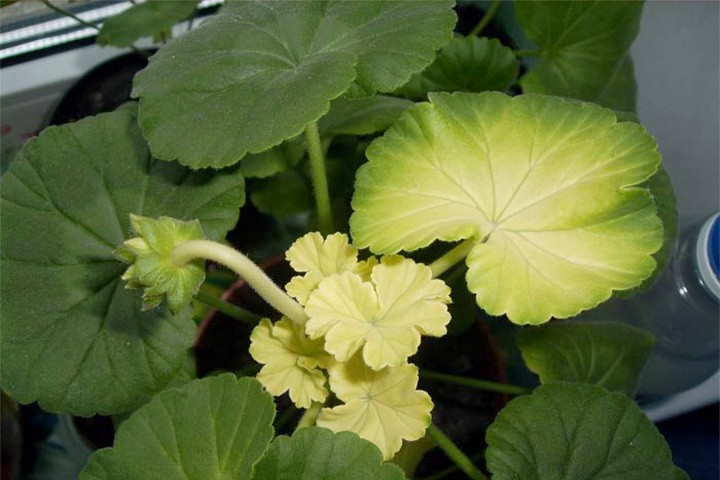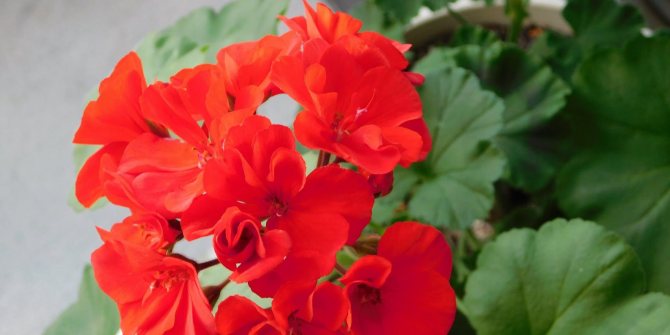Main reasons
Geranium belongs to unpretentious plants, so it can be started by novice growers. Over the years of selection, hundreds of varieties have been bred, which differ not only in color, but also in the shape of the flower. This variety quickly made geraniums popular.

Instances without flowers look unattractive
The plant is correctly called pelargonium, but such a name did not take root. Some varieties can be grown in the garden. Zonal species bloom almost all year round. Their peculiarity is that the flowers have several shades.
Compact geranium with an unobtrusive aroma is Scented. The most beautiful is Royal Pelargonium. Flowers can reach 15 cm in diameter, with a dark speck on each petal.
Important! At home, geranium blooms from March to September. To do this, you need to create the right conditions of detention.
Correct pinching
Timely pruning of weak and elongated branches saves the strength of the plant. Pinching allows you to stimulate the appearance of lateral shoots, which can also bloom.
You need to prune in early spring. For this, the upper part of the stem is removed. It can be rooted and germinated separately
Young plants (up to two years old) are pruned every 3-4 months, since at this stage it is important to achieve the correct formation of the crown
Pinching is carried out with a stationery clean knife or scissors. If the branches were able to stretch out strongly, then they can be pruned a little more. It is better to put the pot with the plant in a sunny place, as the light will allow it to recover faster.

Without pinching, geranium looks ugly, since the stems can be very stretched
Important! Special attention should be paid to the condition of the stems. If they are affected by diseases or pests, they must be cut along with a healthy area of 3-4 cm
Incorrect cropping
Many people want to achieve a violent flowering of geraniums and for this they use various tricks. Any pruning must be done according to the rules, otherwise it will harm the plant.
The shoot is cut off only 1/3 and the uppermost part is removed. It is this technique that helps to awaken the lateral buds. Sometimes a person can overdo it and remove most of the stem. In this case, the geranium may stop growing for a while.
Important! If you are afraid to remove too much, then it is enough to remove 2-3 cm of the top of the shoot. It is impossible to correct the wrong pruning, you just have to wait for it to grow the stems
In this case, you can find out how to fertilize geraniums, since top dressing stimulates growth
It is impossible to correct the wrong pruning, you just have to wait for it to grow the stems. In this case, you can find out how to fertilize geraniums, since top dressing stimulates growth.
Cramped pot
Timely transplantation of geraniums allows the root system to develop correctly. With a lack of soil, there is a deficiency of nutrients and the geranium does not have enough strength to form buds.
Too large a pot will also harm, since then the plant will begin to actively grow the root mass, and not the peduncles. Determining the size of a normal container is simple - it should be 1-2 cm larger than the earthen coma.
You can visually determine the tightness of the pot. The roots will be visible above the ground, and they can also grow through drainage holes.
Important! Geraniums up to three years old are transplanted every year in early spring. This must be done before flowering.
Plants over three years old are transplanted once every two to three years.
Temperature violations
Making geraniums bloom is not so easy, since the formation of buds occurs only when special conditions are created.

A dormant period is required to stimulate flowering.
In spring, summer and autumn, the temperature should be kept at 23-25 ° C, and in winter it should be lowered to 16 ° C. Such changes will allow the plant to expend less energy and accumulate nutrients in the stems and leaves.
During the dormant period, geraniums are rarely watered, they are illuminated for at least 5 hours a day.
Important! When winter has passed, you can start gradually increasing the temperature and the number of waterings. The appearance of the plant can tell about the correctness of the regime.
Red foliage indicates that the geranium freezes and needs to be placed in a warm place.
The appearance of the plant can tell about the correctness of the regime. Red foliage indicates that the geranium is freezing and should be placed in a warm place.
How to make geraniums bloom
If the geranium does not bloom, it is not satisfied with the conditions in which it is located, or the plant is not healthy. First, you need to review the temperature conditions and watering regime. If the plant is indifferent to the humidity of the air, then a lot depends on the state of the soil.
Conditions for flowering
Waterlogging is dangerous for the plant, stagnant water leads to decay of the roots and the death of pelargonium. To prevent this from happening, drainage mixtures are used. Water the plant when the topsoil dries up. Young flowers and shoots are recommended to be moistened using the tray in which the pot is located. In addition to over-watering, insects or fungal diseases can cause severe damage to the roots of the plant. Eliminating them does not cause problems; this is done with the help of special means, removing the affected areas of the plant. If the problem was in pests, in the near future, pelargonium will recover and bloom.
Remember! The container for planting must be selected in a small size. It is better to let the plant be slightly cramped than too spacious. If geranium grows in boxes, then the distance between flowers should be about 3 centimeters. You can plant several bushes in one pot, it is believed that pelargonium loves competition. Therefore, such conditions will give an impetus for flowering.
Also, one of the reasons why pelargonium does not bloom is a lack of sunlight or an excess of it. The main thing is to avoid direct rays, but also not to keep the plant in the shade throughout the day. In such conditions, the plant will survive, but will not be attractive, it will lose its decorative appearance. Royal geranium is especially fond of light, which has larger leaves.
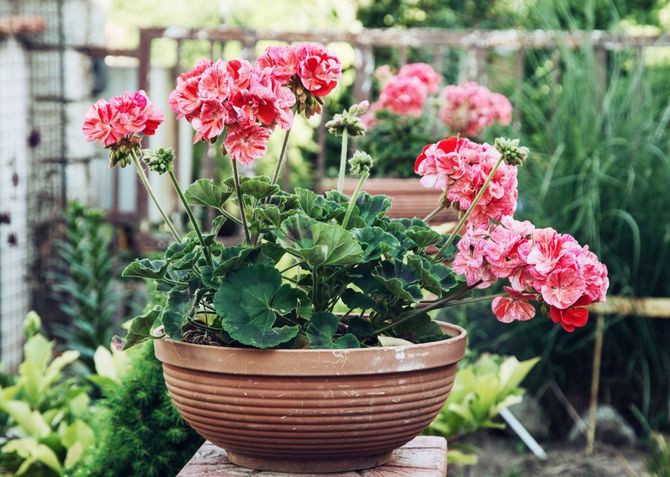
Geranium in bloom
Expert advice
Experts, in order to make geraniums bloom, recommend arranging a temperature difference for it. For example, send it to a cool balcony or take it out into the garden. This is true for spring and summer, when the warmth in the daytime gives way to coolness at night. At the same time, frost and temperatures close to zero must be avoided, otherwise the plant will die. Also, there should be no drafts that harm pelargonium.
Perhaps the plant is out of place, so you can move it around the room in search of a comfortable position. If the geranium starts to bloom, you need to leave it alone.
It is not recommended to put geranium next to moisture-loving plants, this can cause yellowing of the leaves and affect flowering.
Soil composition
Geranium prefers loose soil and the obligatory presence of drainage. Young plants are recommended to add to the soil:
- sand;
- peat;
- perlite.
If you do not use soil created specifically for geraniums, then you can purchase black soil and mix perlite with it. It improves the quality of the soil, absorbs moisture, gradually giving it back to the plant. It also lowers excess soil acidity, which can harm geraniums, and provides air access to the roots. It is recommended to add river sand to the soil.
Additional Information! The quality of the soil can be checked by wetting it and holding it in the palm of your hand. If it crumbles, it is suitable for use; if knotted into a ball, it is better to discard it.
Garden soil is also used, mixing it with sand and peat.
Ideal for planting geraniums is soil prepared from:
- peat;
- sand;
- turf;
- leafy land;
- humus.

Perlite in the ground
Loose and porous soil promotes plant growth and helps it bloom. Excess moisture and increased acidity, on the other hand, can harm geraniums.
Why geranium does not bloom at home

Geranium (Pelargonium) is prized for its lush and very spectacular bloom that lasts for several months. But if the rules of care or the conditions of keeping at home are not followed, the bush will bloom very poorly, or inflorescences will not form on it at all. In this article I will try to name all the main reasons why not indoor geranium blooms.
The main reasons why geranium does not bloom
Pelargonium is distinguished by its unpretentiousness and undemanding care, and in order for it to stop blooming, you need to "try" hard. But unfortunately, this happens quite often. Several main reasons for poor flowering of geraniums or its complete absence will be described in detail below.
Depleted substrate
 Improper feeding is a mistake due to which geranium does not bloom
Improper feeding is a mistake due to which geranium does not bloom
Despite the fact that a nutritious substrate was used during planting, as the flower grows and develops, it is depleted. Therefore, when growing geraniums in indoor conditions, an adult bush is transplanted at least 1 time in a couple of years, and it will also need regular feeding. For a more lush flowering, it is recommended to use phosphorus-potassium fertilizers.
Iodine perfectly stimulates the flowering of such a plant. To do this, it must be watered from time to time with a solution consisting of 5 glasses of well-settled water and 1 drop of iodine.
 The soil can be purchased at the store, or you can prepare it yourself
The soil can be purchased at the store, or you can prepare it yourself
It is extremely undesirable to grow such a flower in clay soil, since it does not allow liquid to pass through well, and this harms the root system of the bush. For this purpose, it is best to use a neutral, light, loose, well-drained substrate that is permeable to air.
Do not forget to make a drainage layer at the bottom of the pot before planting, and broken brick, expanded clay or pieces of foam plastic are best suited for this.
Irregular pruning
 In order for the bush to bloom not only regularly, but also violently, it must be cut in a timely manner and correctly
In order for the bush to bloom not only regularly, but also violently, it must be cut in a timely manner and correctly
This is done in early autumn or in spring, while removing yellow leaf plates, dried stems, and all the branches growing from the axils of the leaves (not from the root). You should also cut the stems growing inside the bush.
Unsuitable pot
If the container in which pelargonium grows is very large, then it will actively grow roots and greens to the detriment of flowering.
 Pelargonium does not like it when there is a lot of free space and seeks to grow
Pelargonium does not like it when there is a lot of free space and seeks to grow
That is why a pot is chosen for such a flower, which will be only a few centimeters larger than the root system of the bush.
Avoid stagnation of liquid in the root system of the flower; for this, try to adhere to the correct watering regime.
 It should be watered only when the topsoil has dried.
It should be watered only when the topsoil has dried.
If you systematically fill the plant, then it will not only stop blooming, but can also wither and, in the end, die. Geranium is one of those crops that tolerate a short drought much easier than waterlogging.
 The dormant period of such a plant is observed during the cold season.
The dormant period of such a plant is observed during the cold season.
If during this time it rests well, then its flowering will be more abundant and beautiful. And for this, it must be rearranged in a cool (from 13 to 15 degrees) and well-lit place. It is watered very sparsely and infrequently, while protecting it from drafts.It is also recommended to supplement the flower every day for at least 5 hours.
Expert advice for lush bloom
 The flowering of pelargonium will depend on the care of the plant.
The flowering of pelargonium will depend on the care of the plant.
To achieve abundant and regular flowering of geraniums, experts recommend:
- If the bush does not bloom, then it must be systematically rearranged in different places on different windowsills, which will help to find the place that suits it best. However, as soon as the buds are formed, it is forbidden to turn and transfer the bush, otherwise they may fly around.
- As soon as the buds are formed, you need to pinch the tops of the shoots, thanks to this, the bush will not build up green mass, which will have a beneficial effect on flowering.
- When growing several bushes at once in one container in the spring, it is imperative to replace the top layer of the substrate with a thickness of about 30 mm with a new one.
Shock therapy
"Shock therapy" is used only in extreme cases, when all the tips described above did not help to achieve abundant flowering of geraniums. To do this, you should carry out a strong pruning, during which only 2 or 3 eyes should be left on each of the branches.
 Try transplanting a flower outdoors
Try transplanting a flower outdoors
Also, if possible, the flower is transplanted into open ground. They do this in the last spring or first summer weeks. At the beginning of autumn, the bush is again planted in a container and brought into the house.
No pruning and transplanting
Geraniums require timely transplantation and pruning. If you carry out these procedures at the wrong time or ignore them, then in due time the pelargonium will not have buds and it will only stretch out.
As soon as the plant begins to stretch, you should immediately cut off the excess branches and leaves, forming a neat bush.

Pelargonium fragrant
Lemon geranium also blooms modestly and rarely. With proper care, flowers appear only in the summer.
When growing these varieties of pelargonium, do not expect abundant flowering.
Most often, geraniums do not bloom with improper or insufficient care. Providing all the conditions necessary for the plant in most cases helps to achieve the appearance of bright flowers in the pelargonium.
7 How to tell the plant's reaction?
If you want to have healthy geraniums, you do not need to require constant flowering from it. It just doesn't happen, because it's unnatural. Blooming is a very costly process. The fact is that any plant that lives from photosynthesis supports its body on the difference between respiration and biosynthesis. In this case, respiration means the oxidation of cell organics in order to obtain energy. Waste products - water and carbon dioxide are released into the environment. Biosynthesis is the process of the formation of new organic substances by the body itself. This is a universal principle of the functioning of any living organism.
Only plants produce organic matter from inorganics (water and carbon dioxide) under the influence of photons of light. If the process of photosynthesis slows down or stops altogether, costs, that is, respiration, begin to exceed income, that is, biosynthesis. The plant does not lose weight like animals, it begins to shed its leaves, and then itself dies. In order to provide a flower with the necessary substances, and especially a lot of flowers, the plant needs to activate the process of photosynthesis several times or take the necessary substances from other organs.
Even under the most favorable conditions, any flowering plant at some point stops forming buds and goes to rest. Otherwise, it will die. This is the case with those plants that are heavily fed to stimulate flowering. This is usually done in flower shops selling beautifully flowering plants in pots. Buy such beauty, bring it home, the plant will last for at least 2 or 3 weeks and die. It was it that was exhausted by the stimulants.

So there is no need to worry if your beloved geranium suddenly stopped blooming, and began to grow leaves and young shoots. It is she who gathers strength before the active process of reproduction, that is, flowering.
You need to give your pet a rest. And if the rest is too long, spring is already coming, and the geranium does not even think to bloom, pour it with potassium-phosphorus fertilizers. Most likely, the result will not be long in coming. Soon your home will be filled with geranium flowers.
Care advice
- Correct watering. In winter, pelargonium is rarely watered, it is enough not to let the earth dry out. In the summer, the procedure becomes more frequent and increases in volume. You don't need to overdo it. Watering with a pallet is considered a safe option. So the roots will never rot, the soil will always be sufficiently moist, and the humidity around the flower will be optimal.
- Top dressing. Flowering plants are fertilized with complex mineral supplements. It is recommended to start from the end of February. Once every 3-4 weeks, a mineral solution is introduced, which includes potassium. When flowering occurs, feeding is carried out more often, 1 time in 14 days.
- Transfer. This is an essential element in the care of pelargonium. It serves to renew the soil and provide a suitable container. A transplant is done in the fall. Royal pelargonium does not tolerate strong winds and scorching sun, so if a florist decided to put it outside for the summer, then a new pot must be placed in a gazebo, on a veranda or in other protected places.
- Pruning. A procedure that aims to balance the aboveground and underground parts. It is produced after flowering ends. Lateral shoots are subject to removal, the main ones are only shortened, excess foliage and peduncles are removed.
Geranium stretches but does not bloom
We recommend reading our other articles
-
Cucumbers in tomato for the winter
-
How to transplant grapes
-
Best Egg Breeds
-
The best breeds of laying hens
Most often, geranium begins to grow vigorously upward at home if it does not have enough light. This can be observed at any time of the year. To prevent this from happening, it is necessary to correct the lighting, put the pot on a lighted windowsill or supplement it with a phytolamp in winter, for example.
The second reason for pulling shoots in the absence of flowering is a large pot. Geraniums don't need much space. In a large container, it builds up the root system and greenery, but almost never blooms. But if you choose a small pot for culture, then the flower, on the contrary, will begin to bloom.
Interesting!
To provoke a beautiful flowering, you can plant several geranium flowers in one container with a distance of up to 5 cm.When competition appears in space, geranium releases flowers, and even its foliage becomes more saturated in color.

Quality insecticides are used to control pests
Follow-up care rules
In order for geraniums to grow and bloom well, it must be properly looked after throughout the year, knowing all the features of this flower. The most important moment in development is spring awakening, when the bush is actively growing. At this moment, you need to help the plant as much as possible and apply suitable mineral fertilizers
It is important that the amount of nitrogen is not more than 11%, because high rates will contribute to the appearance of exclusively greenery, without any flowering
With the installation of stable warm weather, the flower is transferred to open ground or to a balcony. Due to the difference in temperature indicators of day and night, the flower is activated and begins to emit a large number of buds. For abundant flowering, it is worth picking off or cutting off those inflorescences that have already wilted.
Pruning is another important step in the normal development and care of a plant.Normalizing greens, and cutting off old stems helps the bush to bloom, you should not carry out these activities only with royal geraniums, pruning is too much stress for it. The procedure for removing unnecessary parts of the plant is carried out in the fall, and at the end of winter you need to pinch the bush, which in the future will allow the geranium to bloom profusely.

The plant can be pruned in both fall and spring and the procedure will be different. Autumn pruning will look like this:
- remove all faded inflorescences, wilted leaves and stems;
- decide on the shape of the bush and remove all unnecessary shoots;
- remove very long shoots or shoots without leaves - it is better to cut near the lower node, if you leave a stump near it, then a new growth will appear from it later;
- in the process of preparing for winter, it is worth cutting off the main stem by a third of the length;
- the pruning procedure is not carried out in winter, as the plant is dormant.

If we talk about spring pruning, then it is a mandatory event, because it allows you to update the greenery and give an impetus to the formation of flower stalks. Due to spring pruning, the flowering period is inhibited for a couple of weeks, but as a result, the flowers grow larger and more beautiful. It is recommended to carry out these activities in late winter or early spring.
If the bush is large, it is not recommended to cut it heavily, because it will take a long time to recuperate, and this can lead to a complete lack of color. If the bush is young and small, then it can be formed as you like, without harming development. The main criterion for pruning will be the presence of at least two buds on the plant.
To create optimal conditions, the flower should be transplanted into open ground, so caring for it will be easier, and natural conditions will contribute to active growth and flowering. It is quite easy to determine the time for a transplant, the main factor is the absence of significant temperature changes during the day or at night. By autumn, it is worth planting the geranium again in a pot, cutting it off strongly so that the bush begins to prepare for winter. The organization of a cool temperature will make it possible for pelargonium to gain strength over the winter and actively grow with the onset of spring.

As for leaving during flowering, it should be as correct as possible so that this process is longer. Watering and feeding, which are carried out in a timely manner, are important. If you devote maximum time and attention to a flower, you can easily understand how exactly you need to care for it.
- If the leaves begin to turn yellow and fall off, it means that the watering is insufficient and it needs to be increased. It is worth evaluating the humidity and temperature of the room in which the flower is located and adjusting the amount of moisture introduced.
- If the foliage begins to wither and rot, then this is an indicator of excessive flooding of the flower. The solution in this situation would be to stop watering for a while and place the pot in the sun.
- The edge of the foliage begins to turn red due to exposure to cold. The flower can be located very close to the glass in winter, which causes the leaves to freeze. It is worth moving the pot away to protect the crown.
- The foliage thins, falls off, exposing the stem - all these are the reasons for the lack of light. You can solve the problem by rearranging the pot on the windowsill, which is better illuminated by the sun.


For information on why geraniums do not bloom and what to do, see the next video.
How to do it correctly?
To pinch the geranium correctly, you need to do the following:
First of all, it is worth carefully examining the shoot, which must be suspended in growth. The largest bud is found on it - this is the growth point, which is responsible for the active development of the flower. If you do not remove the bud at the top of the stem, then it will continue to grow in height, while the lateral layers will not form.
We found the main bud on the top of the head, gently pinch it with clean hands, if the stem is already woody, then you can take small scissors or a clerical knife and cut it off
The operation must be carried out carefully so as not to damage the young leaves nearby and not break the stem.
It should be understood that after a certain time, the main stem will continue its growth upward, but during the time it adapts, the lateral buds will wake up on it and give branches.
To form a bush, it is worth watching where the buds wake up first. If the shoots began to grow in the wrong place where you need them, they are removed completely, then the buds you need will begin to lay off.
In addition, you should pay attention to the following nuances:
- The tools that will be used for pinching must be disinfected - preferably using alcohol. In addition, scissors or pruning shears should be sharpened, and it is better to take a new blade into a clerical knife so as not to unnecessarily injure the geranium. Hands should also be treated so as not to infect a third-party infection.
- If no tool is used when plucking a geranium, then try not to pull the plant by the shoot, this will injure it and it will take a very long time to recover.
- As soon as all procedures are completed, the plant is transferred to a warm, well-lit place. In order for young layers to develop well, they need a lot of sunlight and heat.
- If unhealthy shoots appear on geraniums, they are immediately removed with a part of a healthy shoot, by about 2-4 cm.
- Places of cuts and pinches should be treated with antiseptic agents. It can be brilliant green, wood ash, activated carbon. If this is not done, the plant may get sick or begin to dry out from the cut.
If you do everything correctly, then geranium will soon delight you with new shoots.
To make it thicker
In order to end up with a blooming compact bush on the windowsill, the upper bud should be removed from the main shoot.
At the same time, the growth of the plant stops, it begins to gain strength to awaken the lateral growth points. If the stems begin to grow from the bottom of the main stem, then they should be removed so that the plant gets a spherical shape.
So as not to grow up
To stop the growth of the geranium, the top of the stem is removed. But sometimes it happens that after this procedure, the layers begin to grow at the top of the main stem - they need to be removed.
The shoots that grow along the stem must also be pinched at the top point of growth so that they do not grow above the shortened main stem. If buds appear on the flower at this time, they should also be removed immediately, otherwise the lateral shoots will be thin and weak.
Bloomed magnificently
It should be understood that only young layers are gaining color in geraniums, therefore, in order to obtain a magnificently flowering plant, it is necessary to carry out a systematic pinching. 5 leaves are left on a young layer, the rest is removed. On all shortened layers, lateral buds will begin to wake up, and as a result, a magnificent plant with a lush, blooming crown will flaunt on the windowsill.
Pinching a seed-grown plant
If the geranium is planted with seeds, then the pinching begins as soon as 6-8 pairs of true leaves are formed on the young plant. In addition, only the axillary layers formed from the bottom of the main stem should be left on the young geranium. Layers should be mercilessly removed from the top.
Anyone who grows geraniums or is just planning to do this will benefit from the materials of our experts on feeding a flower, including iodine, on choosing a soil and a pot, as well as on how to properly transplant and plant a plant.


